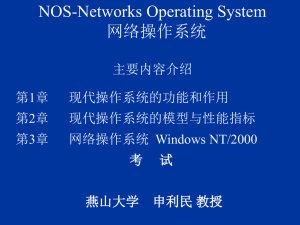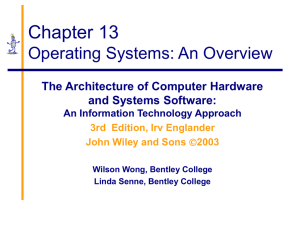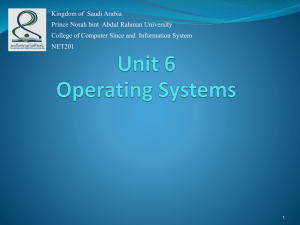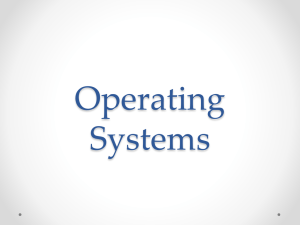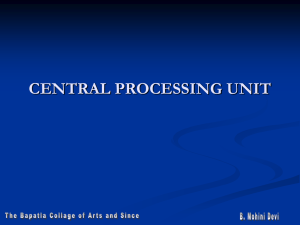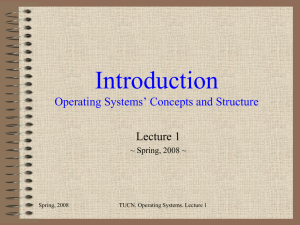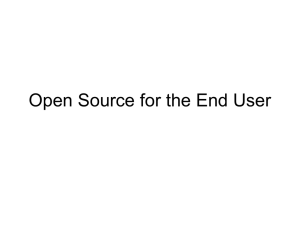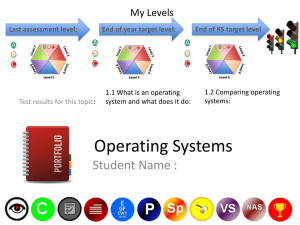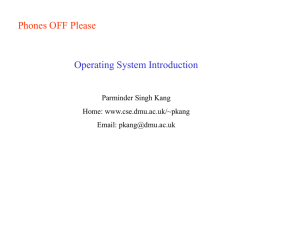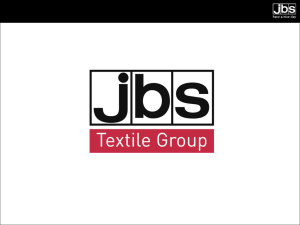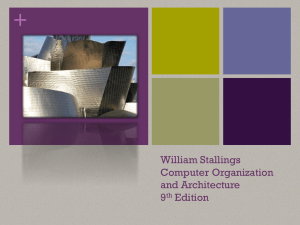Chapter10
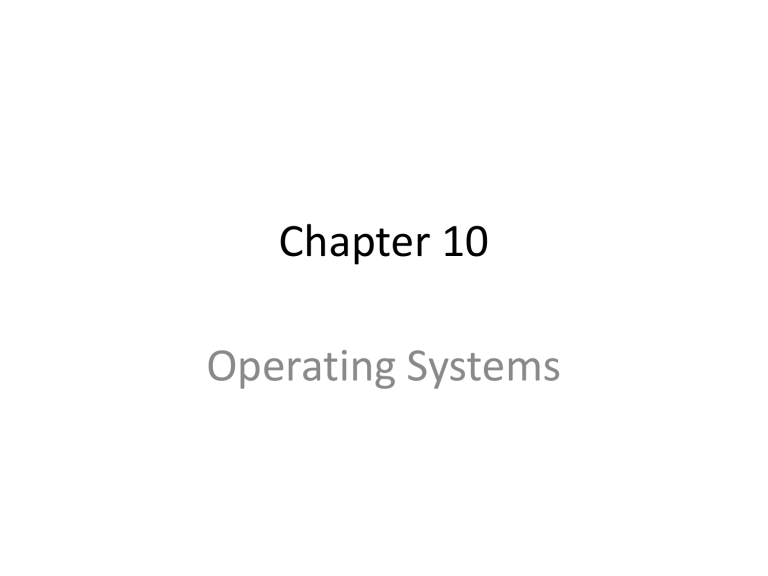
Chapter 10
Operating Systems
Chapter Goals
• A little History of Operating Systems
• Be familiar with current Major Operating
Systems
• Contrast Applications Software and Systems
Software
• Describe the main responsibilities of an operating system
10-2
3
More Chapter Goals
(OS Responsibilities)
• memory and process management
• timesharing and the virtual machine illusion
• logical and physical addresses
• memory management techniques
4
More Chapter Goals
(OS Responsibilities)
• fixed and dynamic memory partitions
• demand paging and the virtual memory illusion
• stages and transitions of the process life cycle
• CPU scheduling algorithms
2 Kinds of Software
• Application software
– Software written to address specific needs
– To solve problems in the real world
– The reason you buy the machine
• System software
– Software that manages a computer system at a fundamental level
– It provides the tools and an environment in which application software can be created and run
10-5
Application Software
• Word processing programs, games, inventory control systems, automobile diagnostic programs, and missile guidance programs are all application software
•
The
stuff you want
10-6
Systems Software
• Operating Systems, File Systems Software,
Utilities (Disk Defragmenter), Compilers,
Maybe a Web Browser
•
The
stuff you need
10-7
Major OS’s
• Unix
• Windows
• Linux
• Mac OS
• Embedded OS’s (Android, iOS)
• Real-Time OS’s
10-8
Which is the BEST OS??
• NONE are “best”
• Consumer POV
– Buy whatever turns you on
• Professional POV
– Cost, tasks, maintenance, support, legacy issues, popularity (network effects), etc.
10-9
A Little History - Mainframes
• Mainframes – from 1950
1. Earliest computers had no OS at all!
2. Proprietary (custom) OS’s
3. VMX
4. Early Unix versions
5. Unix was invented at AT&T Bell Labs
10-10
• Circa 1950
Mainframe
10-11
Mainframe
• IBM System 360 circa 1964
10-12
A Little History - Unix
• Mainframes were often shared by many users
• A multiuser OS was needed
• Unix arose to fill this need
– IBM, Digital Equipment Corporation (DEC), Honeywell,
Hewlett Packard
– Each had their own proprietary version on Unix
10-13
A Little History – Early Personal
Computers
• Microcomputers based on the first integrated
CPU chips ~ late 1970’s
– MITS Altair 8800 (MS’s big break)
– Commodore 64
– Atari ST
– TRS 80
– Apple 2 (Apple 1 was a kit)
– Each machine had their own proprietary OS (or none at all for the Altair!)
10-14
! THE MICROPROCESSOR !
• Intel 8080 – circa 1974
10-15
• Altair 8800 - circa 1975
10-16
A Little History – PC’s n Macs
• PC’s and Macs – 1980’s
– IBM PC
• IBM hired MS to supply DOS (A basic command-line OS )
• MS bought DOS from another party
– Apple Macintosh
• Apple wrote there own GUI OS
• Apple borrowed the idea from Xerox
PARC
10-17
A Little History – Windows OS
• IBM PC needed a GUI
– IBM hired MS to write OS2 for PS2 (not Playstation!)
– MS wrote Windows at the same time
– Guess who won?
– Why did MS win?
• DOS was a “cash cow” for MS
• Windows had backward compatibility w DOS
• PC hardware was cheaper than Mac HW
10-18
What is Linux???
• Linux is based on a free source code version of
UNIX
• This source is compiled to Intel CPU machine code
• Commercial versions are available
• Internal SW architecture is circa 1960’s
(A multi-user OS for a single-user machine)
10-19
What is Linux???
• It’s all about the
$$$$$$ MONEY $$$$$$
• Linus Torvald’s lead the creation of Linux so that he could run UNIX-based code on cheap
PC hardware
10-20
Where are the computers??
• The machines you SEE
– Windows: Almost every desktop in the USA and the world
• The machines you DON’T SEE
– There are lots of UNIX-based machines behind closed doors
10-21
Why is Linux Important
Three Main Reasons
1) Academia
CS discipline was built with UNIX systems
2) Replacement of legacy hardware
Linux on PC is cheaper than “Big Iron”
3) Internet plumbing
Is all Unix-based, will not be re-done
10-22
Why is Linux Important
Academia
• There is a lot of code and textbooks written for a UNIX point of view
• Linux allows you to use this stuff on cheaper hardware
10-23
Why is Linux Important
The UNIX Legacy
• There is a lot of application code running on old expensive Unix mainframe and workstation machines
• Linux is replacing these machines because it runs on cheaper hardware
10-24
Why is Linux Important
The Internet
• Internet routers and other hardware where originally run on old expensive Unix machines
• Linux is replacing these machines because it runs on cheaper hardware
• Learn Linux if you plan to study computing more
10-25
What about Wintell?
• Windows/Intel machines will probably hang around as legacy systems, boring, but part of the standard infrastructure.
• The “Platform” is standard and widespread
• Lots of existing programs for Wintel – it has its own legacy (like UNIX)
10-26
Dominant OS’s:
The Recent Past
• Windows on the “front end”
• Linux on the “back end”
10-27
Dominant OS’s:
Present and Near Future
• Mini Front End (Simple Interfacing Tasks)
– Tablets and Smart Phones
• Maxi Front End (More demanding specialized work)
– Windows
• Back End (Server processing)
– Linux
10-28
LETS GET TECHNICAL
• A major OS job is to provide:
INTERFACES
10-29
OS: Interfaces
Figure 10.1
An operating system interacts with many aspects of a computer system.
10-30
LETS GET TECHNICAL
• The OS is there mainly to do what we all learned in Kindergarten:
SHARING NICELY
10-31
OS: Resource Management
• File systems, monitor, keyboard, etc
• The OS is in charge of making all the application programs “ share nicely ”
• Examples:
– sending keystrokes to correct application
– Placing overlapping windows on the screen
– Making sure apps don’t access each others memory
10-32
Operating System Resource
Management (Sharing)
• Process Management (Sharing the CPU)
• Sharing IO devices
• Main (Primary Memory) Management
(Shared among many programs)
• Disk (Secondary) Memory) Management
(More sharing)
10-33
Process Management
Sharing the CPU
10-34
OS: Process Management
• Process A program in execution
• Process management keeping track of processes and the states they are in
• CPU scheduling determines which process in memory is executed by the CPU at any given instant in time
10-35
More History 1950’s-1960’s
• Batch Processing
– One big (expensive) machine
– One human operating system – “The Operator”
(ala The Matrix)
– Several similar jobs were organized into “batches” that required the same resources
– Example:
• Load the compiler
• Run all the programs to be compiled
10-36
History: Batch Processing
Figure 10.2 In early systems, human operators would organize jobs into batches
10-37
More History: 1960’s-1970’s
• Timesharing
– One big (expensive) machine
– Each user had her own virtual machine , in which all system resources seem to be available for use
– In reality, resources are shared
• Unix was created as a multi-user timesharing operating system
10-38
More History: 1970’s-now
• Multitasking
– Lots of cheap PC machines
– Timesharing evolved into multitasking
– ONE user running MANY PROGRAMS
– Still, resources must be shared by several programs
• Windows was created as a single-user multitasking operating system
10-39
Process States
• The Process States
Figure 10.8 The process life cycle
10-40
The Process Control Block
• The operating system must manage a large amount of data for each active process
• Usually that data is stored in RAM in a data structure called a Process Control Block (PCB)
• The OS maintains one PCB for each process
10-41
Processes are like
Several Cooks Sharing ONE Kitchen
10-42
CPU Context Switch
• There is only one CPU and therefore only one set of CPU registers
– These registers contain the values for the currently executing process
• Each time a process is moved to the running state:
– Register values for the currently running process are stored into its PCB
– Register values of the new running state are loaded into the CPU
– This exchange of information is called a context switch
10-43
CPU Scheduling
• CPU Scheduling Determining which process in the ready state should be moved to the
running state
– Many processes may be in the ready state
– Only one process can be in the running state, actually running at any one time
• Which one gets to moved from ready to running?
10-44
CPU Scheduling
• Nonpreemptive scheduling The currently executing process gives up the CPU voluntarily
– Batch Processing, the old Mac OS, Windows 3.1 circa 1990
• Preemptive scheduling The operating system decides to favor another process, preempting the currently executing process
– Win 9x and later, Unix, and most other modern OS’s
10-45
CPU Scheduling Algorithms
First-Come, First-Served
– Processes are moved to the CPU in the order in which they arrive in the running state
Shortest Job Next
– Process with shortest estimated running time in the ready state is moved into the running state first
Round Robin
– Each process runs for a specified time slice and moves from the running state to the ready state to await its next turn if not finished
10-46
Page 336
First-Come, First-Served
10-47
Shortest Job Next
• Looks at all processes in the ready state and dispatches the one with the smallest service time
Page 337
10-48
Round Robin
• Distributes the processing time equitably among all ready processes
• Aka “Taking Turns”
• The algorithm uses a time slice, which is the amount of time each process is allowed to run before it is the next process’ turn
10-49
Round Robin
• Suppose the time slice was 50
Page 339
10-50
CPU Scheduling Algorithms
Are they preemptive or non-preemptive? Explain
• First-Come, First-Served?
• Shortest Job Next?
• Round Robin?
10-51
Memory Management
Sharing Primary
Memory (RAM)
10-52
Memory Management
• Memory management The process of keeping track of what programs are in memory and where in memory they reside
10-53
Memory Management
Figure 10.3
Memory is a continuous set of bits referenced by specific addresses
10-54
The Problem
• Every Program Wants to be Loaded to RAM address ZERO
Address Machine Code
------------------------------------------
0000 04 000B BR Main
0003
0x0000
0000 sum: .WORD
0005
0007
0009
000B
000E
0011
0014
0017
001A
001D
0000
0000
0000
C10003
310005
Main: num1: .BLOCK 2 num2: .BLOCK 2 num3: .BLOCK 2
LDA sum,d
DECI num1,d
710005 ADDA num1,d
310007 DECI num2,d
710007 ADDA num2,d
310009 DECI num3,d
710009 ADDA num3,d
0020
0023
E10003 STA sum,d
390003 DECO sum,d
0026 00 STOP
0027 .END
Branching wants to jump to some particular address
10-55
The Solution
• Load them elsewhere and LIE TO THEM
• Aka “Address Relocation”
• A part of “Memory Management”
• When programs ask for bytes from some
RAM location, the OS will give them bytes from somewhere else
10-56
Memory Management
1. Track where a program resides in memory
2. Convert logical addresses into physical addresses
• Logical address An address that the program uses
– All programs start at logical address ZERO
• Physical address An actual address in the main memory device
– A program may not actually be loaded starting at physical address zero
10-57
Single Contiguous Memory
Management
• The Simplest Way:
• Only two programs in memory
– The operating system
– The application program
10-58
Single Contiguous Memory
Management
• A logical address is simply an integer value relative to the starting point of the program
• To produce a physical address, we add a logical address to the starting address of the program in physical main memory
10-59
Single Contiguous Memory
Management
10-60
Partition Memory Management
• Partitions Main memory is divided into a particular number of partitions
• Programs are loaded into available partitions
• Note: A main memory partition is not the same thing as a hard disk partition
10-61
Partition Memory Management
• memory is divided into a set of partitions, some empty and some allocated to programs
• Base register A register that holds the beginning address of the current partition
• Bounds register A register that holds the length of the current partition
10-62
Paged Memory Management
• Paged memory technique P rocesses are divided into fixed-size pages and stored in memory frames
– Frame A piece of main memory that holds a process page
– Page A piece of a process that is stored into a memory frame
– Page-map table (PMT) A table used by the operating system to keep track of page/frame relationships
10-63
Paged Memory Management
• To produce a physical address, you first look up the page in the PMT to find the frame number in which it is stored
• Then multiply the frame number by the frame size and add the offset to get the physical address
10-64
Paged Memory Management
• Demand paging An important extension of paged memory management
– Not all parts of a program actually have to be in memory at the same time
– In demand paging, the pages are brought into memory on demand
• Page swap The act of bringing in a page from secondary memory, which often causes another page to be written back to secondary memory
10-65
Paged Memory Management
• The demand paging approach gives rise to the idea of virtual memory , the illusion that there are no restrictions on the size of a program
• Too much page swapping, however, is called thrashing and can seriously degrade system performance.
10-66
